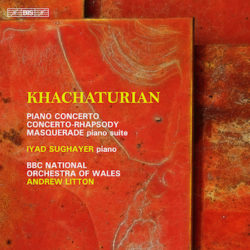Classical Album Review: Khachaturian Piano Music
By Jonathan Blumhofer
Soviet Armenian composer Aram Khachaturian, at his best, was compelling. Granted, he wasn’t working at this level in every piece. But most of his bigger works are better than not.
 What is one to make of Aram Khachaturian? Often lumped with Dmitri Shostakovich and Sergei Prokofiev as part of the triumvirate of Soviet-era compositional titans, his posthumous reputation has been anything but assured.
What is one to make of Aram Khachaturian? Often lumped with Dmitri Shostakovich and Sergei Prokofiev as part of the triumvirate of Soviet-era compositional titans, his posthumous reputation has been anything but assured.
Part of that was maybe predictable. Khachaturian didn’t have a Western presence anywhere near as storied as Prokofiev’s. His biography lacks the drama of Shostakovich’s. Then there’s the music itself, which, as plenty of listeners might suggest, just isn’t that good.
But is it so bad, really? After all, Prokofiev wrote his share of clunkers (a lot of them, actually). So did Shostakovich.
The fact is, Khachaturian, at his best, was compelling. Granted, he wasn’t working at this level in every piece. But most of his bigger works are better than not.
That’s certainly true of his Piano Concerto in D-flat Major. Written in 1936, it hasn’t got the immediacy (or concision) of his later Violin Concerto. But the music’s overriding argument is persuasive, especially in pianist Iyad Sughayar’s new recording of it with the BBC National Orchestra of Wales and Andrew Litton.
Here, the big first movement is smoothly shaped. The second subject’s figures are nicely syncopated while, texturally, everything seems to know where it belongs. Meanwhile, the solo cadenzas are winningly poetic, and the orchestra plays with a focus that’s compelling.
Smartly-balanced textures and an agreeable attention to structure mark the Andante con anima, with its eerie (and well-balanced) flexatone solo. If the finale’s lyricism is, here, a bit less insistent than in Constantine Orbellian’s 1978 recording of the piece, the textures of its Rachmaninoff-esque theme are clearly articulated, the cadenza is boldly done, and the orchestra provides a strong accompaniment.
They do much the same in the composer’s 1967 Concerto-Rhapsody. This is denser music than the earlier Concerto, more abstract, dissonant, and lacking in folk-ish connections.
Yet Sughayar really draws out the machine-like writing of its toccata sections. He also exhibits an exceptionally keen grasp of its dancing third movement: light and playful in tone (if not always so in mood).
Litton draws a mighty accompaniment from his forces. They don’t stint on the music’s pungent dissonances or shaping its meandering form. Indeed, there’s an immediacy to this performance. While it doesn’t hold back from the music’s ambiguity (especially the loud, motoric, dissonant ending), it offers no shortage of lucid and bright moments when those spots come by.
Filling out the disc is an attractive arrangement by Alexander Dolukhanian of Khachaturian’s Masquerade Suite. In Sughayar’s hands, this favorite is at once elegant, lyrical, and spunky, particularly the “Nocturne” and “Galop.”
Jonathan Blumhofer is a composer and violist who has been active in the greater Boston area since 2004. His music has received numerous awards and been performed by various ensembles, including the American Composers Orchestra, Kiev Philharmonic, Camerata Chicago, Xanthos Ensemble, and Juventas New Music Group. Since receiving his doctorate from Boston University in 2010, Jon has taught at Clark University, Worcester Polytechnic Institute, and online for the University of Phoenix, in addition to writing music criticism for the Worcester Telegram & Gazette.
Tagged: Aram Khachaturian, BBC National Orchestra of Wales, Bis, Iyad Sughayar
